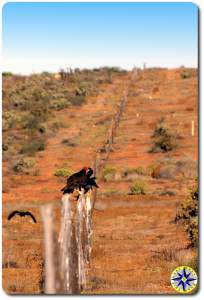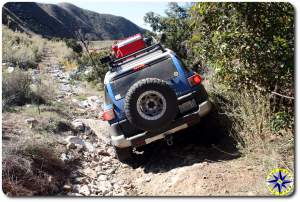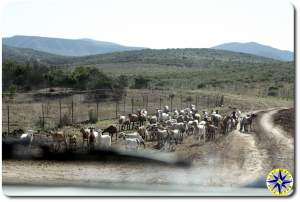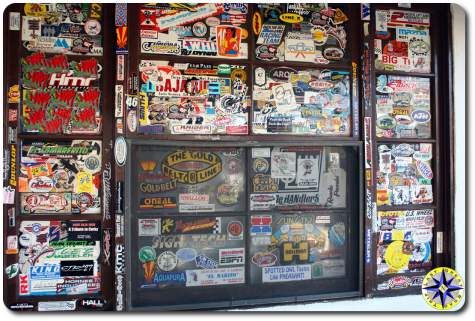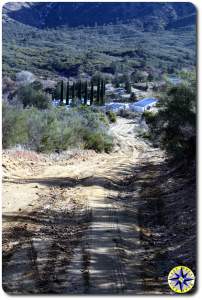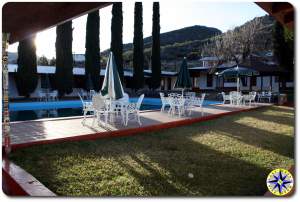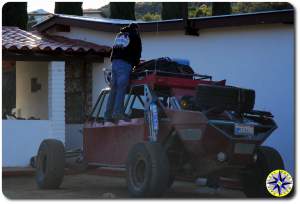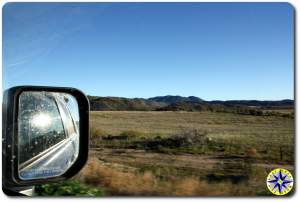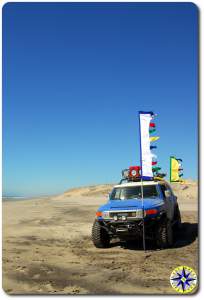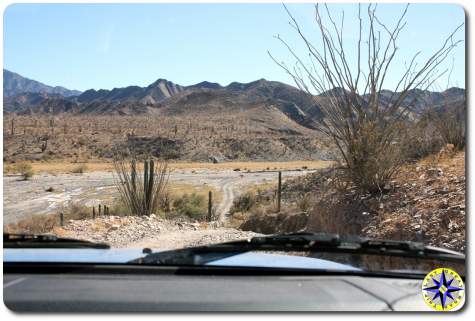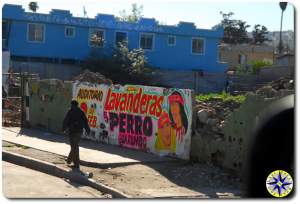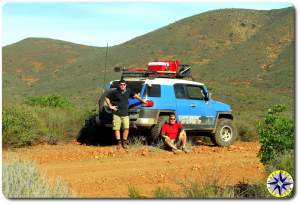 The sadistic, serpent worshiping, demonic bastards who layout the Baja race course have a bad sense of humor. Rather go over the mountains, they steered the off-road course down a river bed that meandered its way through the narrow valley, walled in by the rugged hills.
The sadistic, serpent worshiping, demonic bastards who layout the Baja race course have a bad sense of humor. Rather go over the mountains, they steered the off-road course down a river bed that meandered its way through the narrow valley, walled in by the rugged hills.
Living and wheeling in the Pacific Northwest, I’ve forded my share of streams and creeks. I’ve driven in flooded trails that washed clean the undercarriage of the rig. In the northwest the ground beneath the water is firm with rocks and tree roots to give stability and traction. In the Northwest streams are lined with numerous trees which provide an abundance of anchor point to winch against if you do get stuck.
Getting out to scout the water here we were immediately over powered by the smell of oxygen deprived water backed up from satan’s septic tank. This was shallow stagnant water resting atop soft mucky silt that seemed to go down as far you could push a shovel. Withdrawing a shovel from the muck was akin to a tug-of-war at a company picnic where scrawny pencil pushers compete to pull a line of burly dock workers across an imaginary line in the corporate sand. And as far as an anchor point for a winch was concerned, barren hills with only small scrub bushes lined the marshy river bed.
I told myself, if I stay to left and keep one wheel close to solid ground, momentum should carry us through. Brad told himself and me, that he would get out, wait on the other side and see what happened.
I set the transfer case to four wheel low, engaged the rear locker and proceeded, passing through the muck, not stopping until the wheels reached terra firma 20 yards or so down stream where I waited for Brad to catch up. Looking around I could see a way out, a trail that led back up into the hills on the opposite side. But the hand-held GPS indicated the course remained in the river bed wind through the hills. So we pressed on down stream.
Dry river bed is a bit misleading. Yes there were parts that were dry. Sections of dry gravel, sections of soft dry sand and sections of what can only be described as humpy lumpy vegetation. The river bed oscillated between wide open areas stretching 50 yards across to narrow sections which measured less than 10 yards, hemmed in by vertical walls the water had carved from the hills. In the wide sections you could see three or four different paths the racers had carved out as they opened up their throttles. Each path was separated by walls of vegetation and boulder piles. It didn’t matter which path you picked but once you started down one, you were committed until they all converged again at the next narrow point. Picking the easiest path was a matter of luck since you couldn’t see where any of the paths went as they spread through the vegetation.
We decided to choose based on width at the opening. This didn’t mean it would remain the widest path but it was as good a way to choose as any. While the river bed was dry we drove fast. With tires aired down to 27 psi we floated on the sand and gravel keeping high on the soft terrain and giving us a land yacht like ride. Most of the major ruts and woops created by the 400 horse powered racers had been smooth out by the last flash flood that had swept through making this an ideal section for our little rig.
And than there were the sections of wet. The runoff was down to a thin trickle with low areas where two foot wide mucky trenches held a rancid soup of stagnant water and long stringy bright green moss. These sections demanded slow deliberate driving.
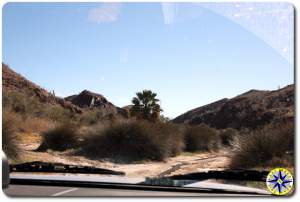 Progress through the mucky channels meant drop the transfer case into four low, put one set of wheels on the high dry ground with the other dredging through the primordial soup. We drove slow but deliberate, keeping forward momentum to avoid getting stuck. The channels invariably serpentine across the trail creating little moments of terror as rig shifted camber dipping both sides of the rig into muck as I scrambled to find dry ground and place at least two wheels on the vegetation above the water line.
Progress through the mucky channels meant drop the transfer case into four low, put one set of wheels on the high dry ground with the other dredging through the primordial soup. We drove slow but deliberate, keeping forward momentum to avoid getting stuck. The channels invariably serpentine across the trail creating little moments of terror as rig shifted camber dipping both sides of the rig into muck as I scrambled to find dry ground and place at least two wheels on the vegetation above the water line.
 But as with everything in the Baja, things change and after an hour of confinement in the river bed, the course turned towards an old two track running away from the far bank. Once again the course placed us on the familiar desert soil.
But as with everything in the Baja, things change and after an hour of confinement in the river bed, the course turned towards an old two track running away from the far bank. Once again the course placed us on the familiar desert soil.
If you drive your rig long enough you know everything about it. Sounds, quirky mechanical habits and little handling oddities gives each rig its unique personality. It wasn’t long before I recognized the blue bunny was making a new sound. Sort of like the squealing of a school girl who’s knuckles are smacked with a brittle wooden ruler in the principles office by Sister Mary Knucklebuster.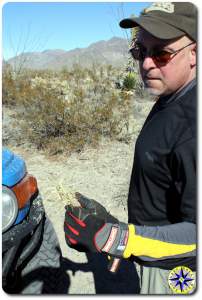
Stopping dead on the trail, we hoped out to take a inventory and investigate. The first thing we spotted were numerous hitchhikers clinging to the sidewalls of our tires. Pulling out the hunks of cactus embedded into the rubber was no easy matter. You risk painful wounds if you try to grab the ball of densely packed three inch spikes. Rather than donate blood I found a long stick to pry the tires free from the cactus’ grip. Although I couldn’t remember where we had run across cactus in the river bed, we pulled several of these spiny bundles from tires.
Listening and checking for leaks we cautiously waited to see if any of the long throngs had punctured through our Toyo’s side walls. For this off-road adventure we carried a spare on the outside of the rig and another inside lashed down in the back. Also tucked away in the back of the rig, a tire repair kit.
We were prepared tire trouble, but that didn’t mean we felt a need to test our tire management skills. So we waited and checked to see if any of the tires were loosing air.
While waiting we went about trying to determine the cause what had originally grabbed my attention, that metal on metal squealing. We pushed and pulled on suspension components, tugged on the gas cans up top, we waggled the high lift jack and rocked the rig back and forth trying to recreate the sound.
The high lift seemed like a good candidate. All the jarring of the day had loosened the mount holding it in place and it made an angry squeal when wiggled. We tightened down the mounts, added some Velcro strips to further lash it down and sprayed a little dry grease to remove any doubt as to it being the source of the screams.
The tires seemed to be holding air and the high lift was secure so we climbed back in rig and continued toward the east. A few hundred yards and again the hairs on the back of my neck were standing at attention. (Yes, I still have hair on the back of my neck… just not the top of my head.) The metal cries were back. Had we bent something in the river bed? Had grit worked it’s way into a the places it shouldn’t? Was something loose and about to let go or fall apart?
We rolled down the trail slowly with the windows down listening carefully. We paid attention to what the rig was doing when the cries came and were they seemed to be loudest. We stopped again and this time armed with a spray can of dry grease I hit the most likely places. A mental process of elimination pointed to the ball joints. The upper and lower control arms of the front suspension are connected to the knuckle with ball joints. They were the most vulnerable to the grit and grim of the river beds muck. A peek behind the tires showed a film of slimy green algae clinging to them. After checking the suspension for any binding and giving the ball joints a spray of grease we crossed our fingers and once more climbed back into the rig.
 Of course we were going to continue. We had too. No tow truck was going to come out here. Besides, what is an adventure without a little drama. 100 yard, 200 yard, a quarter mile and no squealing. We had found the source. This also meant we would need to pay close attention to these ball joints during our daily rig inspection to make sure they didn’t get worse or start to show any wear.
Of course we were going to continue. We had too. No tow truck was going to come out here. Besides, what is an adventure without a little drama. 100 yard, 200 yard, a quarter mile and no squealing. We had found the source. This also meant we would need to pay close attention to these ball joints during our daily rig inspection to make sure they didn’t get worse or start to show any wear.
We had been driving today for nearly eight hours under a spectacular sunny blue sky and we were still on schedule even with all the brakes we took to hydrate, pee and hydrate some more. We were also on course.
The hand held GPS showed us on the route, but with all the tracks running parallel and crisscrossing in front of us it was the old fashion race ribbons that ensured we didn’t mistakenly follow a track off course and into a rat hole. It became a game of find the race ribbon that kept our competitive juices flowing throughout the day.
By late afternoon the course once again dumped us onto a section of highway. This section of smooth fresh asphalt leads to Bahía de los Ángeles (Bay of Los Angeles).
 Bahía de los Ángeles sits at the end of the road forcing many travelers to turn around and head back the way they came. Overlooked by most tourists this small fishing village only recently received electricity. Cell phone coverage was still in the planning stages. Originally the little village was established by Jesuit priests to provide a faster sea route to supply their San Francisco de Borja Mission, which had been located on the top of a mountain 35 kilometers from the bay.
Bahía de los Ángeles sits at the end of the road forcing many travelers to turn around and head back the way they came. Overlooked by most tourists this small fishing village only recently received electricity. Cell phone coverage was still in the planning stages. Originally the little village was established by Jesuit priests to provide a faster sea route to supply their San Francisco de Borja Mission, which had been located on the top of a mountain 35 kilometers from the bay.
This is one of the most beautiful, little secluded bays on the Sea of Cortez. The only visitors in this oasis are sports fishermen, divers, explorers and Baja racers. For us Bahía de los Ángeles held fuel, a meal, a place to stay and well deserved rest making it the most beautiful spot anywhere on earth.



